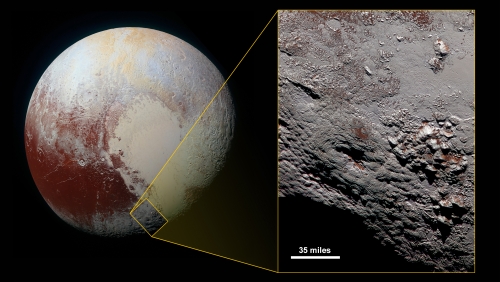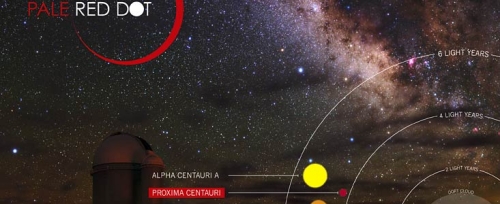Centauri Dreams
Imagining and Planning Interstellar Exploration
Viewing Pluto Over Time
Knowing that the data from New Horizons continues to arrive gives me a warm feeling about the months ahead. Below we have the highest resolution color image of one of the two potential cryovolcanoes found on the surface during the Pluto flyby last summer. This is Wright Mons, some 150 kilometers across and 4 kilometers high. If this is indeed a volcano, none has been discovered in the outer system that can compare with it in size.
Image credit: NASA/Johns Hopkins University Applied Physics Laboratory/Southwest Research Institute.
The image is a composite drawn from New Horizons’ Long Range Reconnaissance Imager (LORRI) on July 14, 2015. The range is approximately 48,000 kilometers, giving us features down to 450 meters across. JHU/APL has also incorporated color data from the Ralph/Multispectral Visible Imaging Camera (MVIC) taken about 20 minutes after the LORRI images were taken, from a range of 34,000 kilometers, and with a resolution of 650 meters per pixel. The scene on the right is 230 kilometers across.
The question most directly raised by the image is the nature of the sparse red material — why is it where it is and why is it not more widespread? You can also see that this must be a relatively young surface, to judge from the fact that there is only one clear impact crater on Wright Mons. This JHU/APL news release speculates that the young surface is an indication that Wright Mons was active relatively late in Pluto’s history.
So hard to believe it’s been ten years since launch…
10 years ago @NewHorizons2015 had raced past the moon's orbit on its way to Pluto. https://t.co/PgnWuLQfkx #OTD pic.twitter.com/ii7BPxOqtO
— Corey S. Powell (@coreyspowell) January 20, 2016
In 2006, just before the launch, David Grinspoon wrote this in the Los Angeles Times:
Theory alone cannot teach us what there is to know. The universe is stranger and more varied than we can predict or calculate, and that is why we explore. We can’t know exactly what New Horizons will find. But we can safely predict that when we get to Pluto — and the whole new class of worlds it represents — what we discover will baffle, surprise, delight and enlighten.
Pluto As We Used to See It
If you think back to what we knew about Pluto when we could only see it from Earth orbit, it’s heartening to see how much we surmised. As Amanda Zangari (SwRI, and a member of the New Horizons’ Geology, Geophysics and Imaging Team) mentions in a recent blog post, we knew that the surface was covered with nitrogen and methane, and also that tholins were common (Zangari calls them the ‘brown gunk made when UV light hits nitrogen and methane’). And the carbon monoxide patch we saw where Pluto was brightest turned out to be Sputnik Planum, the area forming the left side of Pluto’s now famous ‘heart.’
The New Horizons mission has been an outstanding success, but there is a slight frustration in Zangari’s post having to do with the fact that it was a flyby:
I like to think of the whole experience as getting to look at the answer in the back of the book. To extend the back-of -the-book analogy, like many textbooks, we are only getting half the answer. With Pluto, that missing element isn’t the even problems, but time. Our greatest images are from the July 14 closest encounter, and thus we only have one glimpse of one side of Pluto on one day. Yet these images show Pluto as an active world, undergoing volatile-ice transport and change.
True enough — who wouldn’t want to see an orbiter in this fascinating system? — but have a look at the progress we’ve made. Here I’m directly poaching from Zangari’s post to show the best maps we had before the flyby, made from Hubble Space Telescope images in 2002 and 2003.
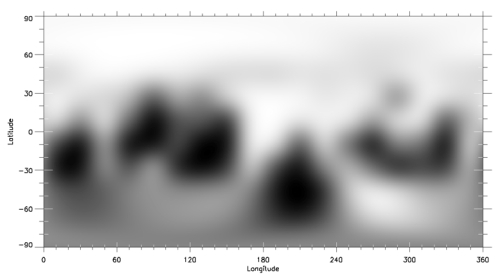
Image credit: NASA/JHUAPL/SwRI/Marc Buie.
And here we are from New Horizons:
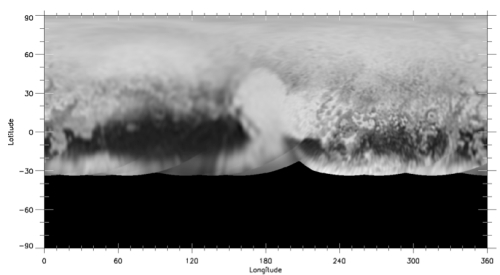
Image credit: NASA/JHUAPL/SwRI.
Zangari tells us that her next project involves comparing measurements of Pluto’s brightness as seen by New Horizons from 2013 to 2015 and comparing these to Hubble Space Telescope observations from 2002 to 2003. The goal: To see how Pluto’s surface has changed over time, a good thing to consider given how surprisingly active the Pluto/Charon system has turned out to be. Sad to think that watching Pluto’s continuing evolution now involves Earth-based telescopes alone. Someday there will be a Pluto orbiter, but none of us can know when.

Is Proxima Centauri a Bound Star?
About 1.4 million years from now, the K-class star Gliese 710, now 64 light years distant in the constellation Serpens, will brush past our Solar System. Moving to within 50,000 AU, the star could be expected to have an unsettling effect on cometary orbits in the Oort Cloud, perhaps dislodging some of these comets to cause them to move into our inner planetary system. An interesting scenario, particularly remembering speculation that comets were a source of water for the early Earth, and may perform a similar function in other young systems.
So just how common are such celestial encounters? We may have one at our very doorstep in the form of Proxima Centauri. The Pale Red Dot campaign that began yesterday is focusing on a red dwarf that is roughly 15,000 AU from the close binary stars Centauri A and B. If you think about what our system would look like with a red dwarf at the inner edge of the Oort Cloud, you can see that Proxima may play a large role in the evolution of the triple-star system.
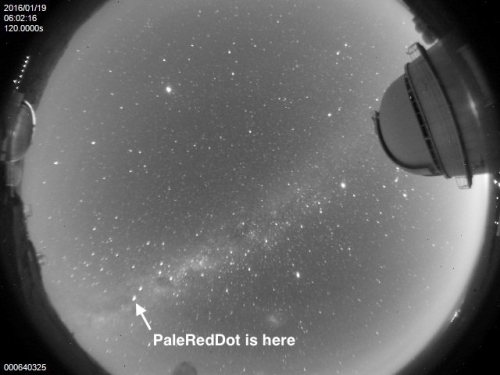
Image: Proxima Centauri, indicated by the arrow, in an image from the first night’s run at the Pale Red Dot observing campaign at La Silla. Credit: ESO/Guillem Anglada-Escudé.
Assuming, that is, that this is a bound system. It was back in 1993 that Robert Matthews and Gerard Gilmore (Cambridge University) studied kinematic data on Proxima and concluded that the star was not necessarily gravitationally bound. In fact, it was on the borderline, and could well be a star that was simply moving past Centauri A and B, having been formed elsewhere. The researchers cited the need for further kinematic data to resolve the matter.
The following year, J. Anosova (Physical Research Laboratory, Ahmedabad, India) proposed that the three Centauri stars were part of a stellar moving group, with Proxima drifting close but not necessarily bound. But the problem would not go away. Proxima’s small relative velocity in relation to Centauri A and B (0.53 ± 0.14 km s-1) makes the likelihood that it is unbound quite small, which is why the assumption of a bound triple system has generally been the rule since the star’s discovery in 1915.
Jeremy Wertheimer and Gregory Laughlin (UC-Santa Cruz) have had the most recent word, finding in 2006 that Proxima is indeed bound to Centauri A and B:
The availability of Hipparcos data has provided us with the ability to implement a significant improvement over previous studies of the α Cen system. Our results indicate that it is quite likely that Proxima Cen is gravitationally bound to the α Cen A-B pair, thus suggesting that they formed together within the same birth aggregate and that the three stars have the same ages and metallicities. As future observations bring increased accuracy to the kinematic measurements, it will likely become more obvious that Proxima Cen is bound to the α Cen A-B binary and that Proxima Cen is currently near the apastron of an eccentric orbit…
The researchers are also able to make a prediction: When we can get a more refined look at Proxima Centauri’s absolute radial velocity, we should see a value of -22.3 km s-1 < vr < -22.0 km s-1. Hence the importance of our continuing investigation of this small star. As we proceed with projects like Pale Red Dot and beyond, we should be able to eventually declare the question of Proxima’s bound status closed.
Ramifications of a Bound Proxima
This is of more than passing interest, because Proxima Centauri could well be influencing the planetary systems (if any) of the two primary Centauri stars. As I mentioned above, a star like Gl 710 passing by our system could cause disruptions in the Oort Cloud, and a passing Proxima Centauri could certainly serve the same function in that system. But a bound Proxima — one that is, as Wertheimer and Laughlin believe, currently located near the apastron position of its orbit, could have useful effects on an infant system. As the paper notes:
If Proxima were bound to the system during its formation stages, then it may have gravitationally stirred the circumbinary planetesimal disk of the α Cen system, thereby increasing the delivery of volatile-rich material to the dry inner regions.
A significant factor indeed as we ponder the question of astrobiology around these stars. Laughlin has written elsewhere about the fact that Alpha Centauri planets will likely be dry because of the close orbit of Centauri A and B — the period of the AB binary pair is 79 years, and the stars make a close approach of 11.2 AU. Silicates and metals condense out of the protoplanetary disks around Centauri A and B, but to get water, we need to go further out, into the circumbinary disk surrounding both stars. A bound Proxima Centauri, then, becomes the mechanism for driving water-laden materials inward to any dry, terrestrial-class planets.
And there is another factor that makes the question of Proxima’s relation to Centauri A and B significant. If Proxima is bound, the implication is that all three stars were formed out of the same molecular cloud, and that would imply not just the same age but the same metallicity (metals being elements higher than hydrogen and helium). We know that both Centauri A and B are richer in metals than our own Sun, and if Proxima is likewise metal-rich, it may have an elevated chance of having planets. The link between gas-giant formation and metals has been well explored, though such a link for rocky worlds is not established.
What all this comes down to is that a gravitationally bound Proxima Centauri would exist as the third member of a system that should be rich in the materials needed to form terrestrial planets. The problem now is to find them using searches like the ongoing effort at La Silla, where the Pale Red Dot campaign will be in progress until April. As mentioned yesterday, you can follow the effort on Twitter: @Pale_red_dot, and use the hashtag #PaleRedDot. Conditions were problematic last night at the observatory but it looks like the first observations were made.
The paper by Matthews and Gilmore is “Is Proxima really in orbit about Alpha CEN A/B?,” Monthly Notices of the Royal Astronomical Society Vol. 261, No. 2 (1993), p. L5-L7 (abstract). The Anosova paper is “Dynamics of nearby multiple stars. The α Centauri system,” Astronomy & Astrophysics 292 (1994), 115-118 (full text). The Wertheimer and Laughlin paper is “Are Proxima and Alpha Centauri Gravitationally Bound?” The Astronomical Journal 132:1995-1997 (2006), available online.

Pale Red Dot: Proxima Centauri Campaign Begins
A new observational campaign for Proxima Centauri, coordinated by Guillem Anglada-Escudé (Queen Mary University, London), is about to begin, an effort operating under the name Pale Red Dot. You’ll recall Dr. Anglada-Escudé’s name from his essay Doppler Worlds and M-Dwarf Planets, which ran here in the spring of last year, as well as from Centauri Dreams reports on his work on Gliese 667C, among other exoplanet projects. Pale Red Dot is a unique undertaking that brings the public into an ongoing campaign from the outset, one whose observations at the European Southern Observatory’s La Silla Observatory begin today.
The closest star to our Sun, Proxima Centauri was discovered just over 100 years ago by the Scottish astronomer Robert Innes. A search through the archives here will reveal numerous articles about the red dwarf and the previous attempts to find planets orbiting it. I’ll point you to a round-up of exoplanet work on Proxima thus far next week, when my essay ‘Intensifying the Proxima Centauri Planet Hunt’ will run as part of Pale Red Dot’s outreach campaign. For now, the short summary is that we can rule out various planet scenarios around Proxima, but the possibility of a rocky world in the habitable zone is definitely still in the mix.

Image: First images of Proxima from the Las Cumbres Observatory Global Telescope Network at Cerro Tololo Inter-American Observatory, Chile.
Pale Red Dot today begins a two and a half month campaign that will run through April using the HARPS spectrograph at ESO’s 3.6-meter telescope at La Silla (Chile). The method here is radial velocity, looking for those infinitesimal Doppler signals showing the star’s motion as affected by planetary companions. These RV studies thus add to the earlier work done by Michael Endl (UT-Austin) and Martin Kürster (Max-Planck-Institut für Astronomie), who studied Proxima using the UVES spectrograph at the Very Large Telescope in Paranal.
But Pale Red Dot’s HARPS data will be complemented by robotic telescopes around the globe, including the Burst Optical Observer and Transient Exploring System (BOOTES) and the Las Cumbres Observatory Global Telescope Network (LCOGT). These automated installations will measure the brightness of Proxima each night during the observing campaign, helping to clarify whether any RV ‘wobbles’ of the star are caused by a planet or by events on the stellar surface. After thorough data analysis, the results will be submitted to a peer-reviewed journal.
The public outreach aspect of Pale Red Dot is compelling. Anglada-Escudé explains:
“We are taking a risk to involve the public before we even know what the observations will be telling us — we cannot analyse the data and draw conclusions in real time. Once we publish the paper summarising the findings it’s entirely possible that we will have to say that we have not been able to find evidence for the presence of an Earth-like exoplanet around Proxima Centauri. But the fact that we can search for such small objects with such extreme precision is simply mind-boggling.
“We want to share the excitement of the search with people and show them how science works behind the scenes, the trial and error process and the continued efforts that are necessary for the discoveries that people normally hear about in the news. By doing so, we hope to encourage more people towards STEM subjects and science in general.”
To communicate the process, Pale Red Dot will use blog posts and social media, with essays from astronomers, scientists, engineers and science writers on the site’s blog. To keep up with the social media updates, use @Pale_red_dot on Twitter for the project account, and you’ll probably want to check the hashtag #PaleRedDot as well. I also want to mention (and this will be in my article next week) that David Kipping’s transit studies of Proxima using the Canadian MOST (Microvariability & Oscillations of STars) space telescope are continuing, and beyond this we have another gravitational microlensing possibility as the star occults a 19.5-magnitude background star this February. Proxima Centauri, 2016 looks to be your year, and perhaps it’s also the year we find out for sure whether there is a planetary system so close to our own.
KIC 8462852: A Century Long Fade?
I hadn’t expected a new paper on KIC 8462852 quite this fast, but hard on the heels of yesterday’s article on the star comes “KIC 8462852 Faded at an Average Rate of 0.165±0.013 Magnitudes Per Century From 1890 To 1989,” from Bradley Schaefer (Louisiana State University). Schaefer takes a hard look at this F3 main sequence star in the original Kepler field not only via the Kepler data but by using a collection of roughly 500,000 sky photographs in the archives of Harvard College Observatory, covering the period from 1890 to 1989.
The Harvard collection is vast, but Schaefer could take advantage of a program called Digital Access to a Sky Century@Harvard (DASCH), which has currently digitized about 15 percent of the archives. Fortunately for us, this 15 percent covers all the plates containing the Cygnus/Lyra starfield, which is what the Kepler instrument focused on. Some 1581 of these plates cover the region of sky where KIC 8462852 is found. What Schaefer discovers is a secular dimming at an average rate of 0.165±0.013 magnitudes per century. For the period in question, ending in the late 1980s, KIC 8462852 has faded by 0.193±0.030 mag. From the paper:
The KIC 8462852 light curve from 1890 to 1989 shows a highly significant secular trend in fading over 100 years, with this being completely unprecedented for any F-type main sequence star. Such stars should be very stable in brightness, with evolution making for changes only on time scales of many millions of years. So the Harvard data alone prove that KIC 8462852 has unique and large-amplitude photometric variations.
That’s useful information, especially given the possible objection to the Kepler findings that they might be traceable to a problem with the Kepler spacecraft itself. Evidently not:
Previously, the only evidence that KIC 8462852 was unusual in any way was a few dips in magnitude as observed by one satellite, so inevitably we have to wonder whether the whole story is just some problem with Kepler. Boyajian et al. (2015) had already made a convincing case that the dips were not caused by any data or analysis artifacts, and their case is strong. Nevertheless, it is comforting to know from two independent sources that KIC 8462852 is displaying unique and inexplicable photometric variations.
As Schaefer notes, KIC 8462852 can now be seen to show two unique episodes involving dimming — the dips described here yesterday for the Kepler spacecraft, and the fading in the Harvard data. The assumption that both come from the same cause is reasonable, as it would be hard to see how the same star could experience two distinct mechanisms that make its starlight dim by amounts like these. The timescales of the dimming obviously vary, and the assumption would be that if the day-long dips are caused by circumstellar dust, then the much longer fading that Schaefer has detected would be caused by the same mechanism.

Image: KIC 8462852 as photographed from Aguadilla, Puerto Rico by Efraín Morales, of the Astronomical Society of the Caribbean (SAC).
Thus we come to the comet hypothesis as a way of explaining the KIC 8462852 light curves. Incorporating the fading Schaefer has discovered, a cometary solution would require some mind-boggling numbers, as derived in the paper. From the summary:
With 36 giant-comets required to make the one 20% Kepler dip, and all of these along one orbit, we would need 648,000 giant-comets to create the century-long fading. For these 200 km diameter giant-comets having a density of 1 gm cm?3, each will have a mass of 4 × 1021 gm, and the total will have a mass of 0.4 M?. This can be compared to the largest known comet in our own Solar System (Comet Hale-Bopp) with a diameter of 60 km. This can also be compared to the entire mass of the Kuiper Belt at around 0.1 M? (Gladman et al. 2001). I do not see how it is possible for something like 648,000 giant-comets to exist around one star, nor to have their orbits orchestrated so as to all pass in front of the star within the last century. So I take this century-long dimming as a strong argument against the comet-family hypothesis to explain the Kepler dips.
If Schaefer’s work holds up, the cometary hypothesis to explain KIC 8462852 is deeply compromised. We seem to be looking at the author calls “an ongoing process with continuous effects” around the star. Moreover, it is a process that requires 104 to 107 times as much dust as would be required for the deepest of the Kepler light dips. And you can see in the quotation above Schaefer’s estimate for the number of giant comets this would require, all of them having to pass in front of the star in the last century.
The paper is Schaefer, “KIC 8462852 Faded at an Average Rate of 0.165+-0.013 Magnitudes Per Century From 1890 To 1989,” submitted to Astrophysical Journal Letters (abstract).

Following Up KIC 8462852
As I sat down to write yesterday morning, I realized there was a natural segue between the 1977 ‘Wow!’ signal, and the idea that it had been caused by two comets, and KIC 8462852, the enigmatic star that has produced such an interesting series of light curves. What I had planned to start with today was: “Are comets becoming the explanation du jour for SETI?” But Centauri Dreams reader H. Floyd beat me to the punch, commenting yesterday: “Comets are quickly earning the David Drumlin Award for biggest SETI buzzkill.”
As played by Tom Skeritt, David Drumlin is Ellie Arroway’s nemesis in the film Contact, willing to knock down the very notion of SETI and then, in a startling bit of reverse engineering, turning into its champion as he claims credit for a SETI detection. And of course you remember controversial KIC 8462852 as the subject of numerous media stories first playing up the idea of alien mega-engineering, and then as quickly declaring the problem solved by a disrupted family of comets that moved between us and the star in their orbit.

But KIC 8462852 doesn’t yield to instant analysis, and it’s good to see a more measured piece now appearing on New York University’s ScienceLine site. The title, Tabby’s Mystery, is a nod to Tabetha Boyajian, a postdoc at Yale University who noticed that the dips in light in Kepler data from the star were unusual. We have the Planet Hunters group to thank for putting Boyajian on the case, and a productive one it has turned out to be. As writer Sandy Ong notes, KIC 8462852 produced non-periodic dips in the star’s light that in one case reached 15 percent, and in another 22 percent.
Image: Yale’s Tabetha Boyajian, whose work examines possible causes for the unusual light curves detected at KIC 8462852.
‘Tabby’s star’ is one name KIC 8462852 has acquired, the other being the ‘WTF star’, doubtless standing for ‘where’s the flux,’ given the erratic changes to the light from the object. I’ve written a number of articles on this F3-class star and its light curves, noting not only the size of the two largest dips but also the fact that the dips, unlike those of a transiting planet, are not at all symmetric. Ong quotes Boyajian as saying: “The first one is a single dip that shows a very gradual decrease in brightness, then a sharp increase… The second dip has more structure to it with lots of ups and downs.” For more, see KIC 8462852: Cometary Origin of an Unusual Light Curve? and search the archives here, where five or six other articles on the matter are available.
Comets come into the mix because in Boyajian’s paper on KIC 8462852, they are named as a possibility. To refresh all our memories, let’s go back to the paper:
…we could be seeing material close to the pericenter of a highly eccentric orbit, reminiscent of comets seen in the inner Solar System at pericenter. We therefore envision a scenario in which the dimming events are caused by the passage of a series of chunks of a broken-up comet. These would have to have since spread around the orbit, and may be continuing to fragment to cause the erratic nature of the observed dips.
Comets moving close to the parent star would be given to thermal stresses, and could also be disrupted by close encounters with planets in the inner system. For that matter, tidal disruption by the star itself is a possibility. Boyajian and co-authors point out that a comet like Halley would break apart because of tidal forces if approaching as close as 0.02 to 0.05 AU.
We have WISE data from 2010 showing us that KIC 8462852 lacks the infrared signature a debris disk should produce. But the unusual light curves from Kepler began in the spring of 2011, so for a brief window between the two, there was the possibility of a planetary catastrophe, perhaps a collision between a planet and an asteroid, that would explain what Kepler saw. But Spitzer Space Telescope observations in 2015, analyzed by Massimo Marengo (Iowa State) and colleagues, found no trace of infrared excess at the later date, which seems to rule out a collision between large bodies and leaves the hypothesis of a family of comets still intact. See No Catastrophic Collision at KIC 8462852 for a discussion of Marengo’s work.
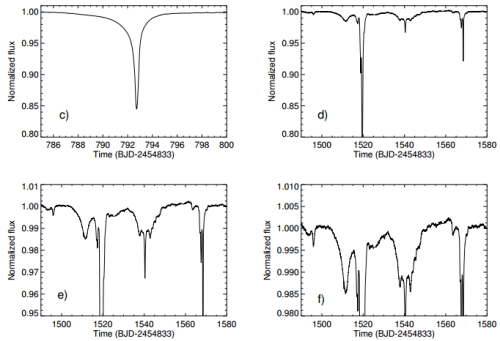
Image: Montage of flux time series for KIC 8462852 showing different portions of the 4-year Kepler observations with different vertical scalings. Panel ‘(c)’ is a blowup of the dip near day 793, (D800). The remaining three panels, ‘(d)’, ‘(e)’, and ‘(f)’, explore the dips which occur during the 90-day interval from day 1490 to day 1580 (D1500). Credit: Boyajian et al., 2015.
Perhaps we’re seeing a natural phenomenon we can’t yet identify. Ong cites Eric Korpela (UC-Berkeley) on the matter:
“I like the comet explanation although ‘comet’ might not be the right word,” says Eric Korpela, another astronomer from the Berkeley SETI Research Center. That’s because the core of such an object would have to be as large as Pluto in order to generate this kind of light, he explains.
Korpela and other astronomers believe the dimming may be due to some kind of natural phenomenon we haven’t yet seen anywhere in the universe. “We just haven’t looked at enough stars to know what’s out there,” he says.
What we saw yesterday with relation to the ‘Wow!’ signal is that we will soon have two chances to monitor the comets involved in Antonio Paris’ hypothesis for generating the signal. In like manner, we’ll have further observations of KIC 8462852. Ong notes that the Green Bank instrument in West Virginia is involved, as are the MINERVA array in Arizona, the MEarth project (Arizona and Chile), the LOFAR telescope in the Netherlands, and amateur observations from the American Association of Variable Star Observers, who will bring their own instruments to bear.
Oh to have a healthy Kepler in its original configuration returning new data on KIC 8462852! But despite the outstanding work being performed by the K2 ‘Second Light’ mission, the instrument is now working on different targets, and our ground-based telescopes have to do the job. What we need to know is if and when ‘Tabby’s star’ starts producing further light curves, and just what they look like. SETI observations have already been attempted using the Allen Telescope Array (see SETI: No Signal Detected from KIC 8462852) looking for interesting microwave emissions. None were found. Expect this enigmatic star to remain in the news for some time to come.
The Boyajian paper is Boyajian et al., “Planet Hunters X. KIC 8462852 – Where’s the Flux?” submitted to Monthly Notices of the Royal Astronomical Society (preprint). The Marengo paper is Marengo et al., “KIC 8462852 – The Infrared Flux,” Astrophysical Journal Letters, Vol. 814, No. 1 (abstract / preprint). Jason Wright and colleagues discuss KIC 8462852 in the context of SETI signatures in Wright et al., “The ? Search for Extraterrestrial Civilizations with Large Energy Supplies. IV. The Signatures and Information Content of Transiting Megastructures,” submitted to The Astrophysical Journal (preprint).

Return to ‘Wow!’
The famous Wow! signal, picked up on August 15, 1977 at the Big Ear radio telescope (Ohio State University) is back in the news, with a new theory suggesting a source for the signal right here in the Solar System. Antonio Paris (St. Petersburg College, FL) asks us to consider a cometary origin for the signal, generated as two comets released hydrogen as they passed near the Big Ear’s search field. The now-dismantled telescope had a fixed field of view, so a bright signature at 21 centimeters — the hydrogen line — would have appeared short-lived.
Specifically, 21-cm refers to the line in the spectrum of neutral hydrogen atoms, a wavelength corresponding to 1420 megahertz associated with the most common element in the universe. It was back in 1959 that both Philip Morrison and Frank Drake fixed on the hydrogen line as a rational place to look for interstellar beacons, the assumption being that any civilization trying to reach another would choose a wavelength associated with some sort of universal constant.
Project Ozma grew out of this as Drake studied the nearby stars Tau Ceti and Epsilon Eridani at this wavelength, while Morrison, working with Giuseppe Cocconi, wrote the most famous paper in the history of SETI, “Searching for Interstellar Communications,” which appeared in Nature in 1959 and is a fascinating read to this day (available online). Hence the interest of Jerry Ehman at Ohio State’s Big Ear, and the enthusiasm with which he wrote “Wow!” on the printout of the signal detected that day in 1977. Had we found an interstellar beacon?

The Cometary Hypothesis
We do know that the ‘Wow!’ signal’s intensity rose and fell over the same 72-second interval that the Big Ear itself could keep an object in its view — with a fixed field of view, the Earth’s rotation governed this. Hence Ehman could assume the signal had an origin in space, and Antonio Paris makes the same assumption. Scheduled to appear in the Journal of the Washington Academy of Sciences, the paper notes that the size of a comet’s hydrogen cloud is determined by the size of the comet, extending for as much as 100 million kilometers in width. The cloud increases significantly as the comet approaches the Sun. From the paper:
Since the rate of hydrogen production from the comet’s nucleus and coma has been calculated at 5 x 1029 atoms of hydrogen every second, the hydrogen cloud is the largest part of the comet. Moreover, due to two closely spaced energy levels in the ground state of the hydrogen atom, the neutral hydrogen cloud enveloping the comet will release photons and emit electromagnetic radiation at a frequency along the hydrogen line (1420.40575177 MHz).
Two comets are of interest. Looking back to 1977, Paris found that from July 27 to August 15, the Jupiter-family comets 266P/Christensen and P/2008 Y2 (Gibbs) were transiting near the Chi Sagittarii star group, placing them close to the source of the “Wow!” signal. Back to the paper:
Of significance to this investigation, the purported source of the “Wow” signal was fixed between the right ascension and declination values… of comets 266P/Christensen and P/2008 Y2 (Gibbs). On their orbital plane, moreover, 266P/Christensen was 3.8055 AU from Earth and moving at a radial velocity of +13.379 km/s; and P/2008 Y2 (Gibbs) was 4.406 AU from Earth and moving at a radial velocity of +19.641 km/s…
If the cometary hypothesis is correct, this would explain why subsequent searches using the Very Large Array and the Ohio State University Radio Observatory between 1995 and 1999 found nothing, for neither comet would then have been near the right ascension and declination values of the original signal. Paris suggests that the period of 266P/Christensen (6.63 years) and P/2008 Y2 (Gibbs) (6.8 years) can explain why the signal was never again detected.
The idea that the Wow! signal was produced from clouds of neutral hydrogen emanating from the two comets seems quite a stretch, but usefully, Paris offers a way to falsify the hypothesis. We learn that comet 266P/Christensen will again pass through the neighborhood of the “Wow!” signal on January 25, 2017, while comet P/2008 Y2 (Gibbs) will be in the area on January 7 of 2018. So we will have the opportunity to test the notion and analyze the hydrogen spectra of the two comets. Shouldn’t the Big Ear have picked up the same cometary signature 24 hours later? We can’t be sure, but scanning the hydrogen signal from each comet sounds like a good idea.
The paper is Paris and Davies, “Hydrogen Clouds from Comets 266/P Christensen and P/2008 Y2 (Gibbs) are Candidates for the Source of the 1977 “WOW” Signal,” accepted at the Journal of the Washington Academy of Sciences (abstract).

